► Our new supermini mega group test
► With the Ford Fiesta gone…
► …what will fill the void?
I went from posters of Lamborghinis on my wall to driving a base-spec VW Polo Mk1, aged 17. Cheap, cheerful, usually petrol, preferably manual, front-wheel drive and light weight, superminis have long provided us with our first cars, offering thrills way beyond their humble status.
And while the supermini is certainly under threat these days – from the manufacturers’ push to premium and electrification – it’s a class that’s far from dead, with a line-up of strong options, both brand new and recently facelifted.
So, in celebration of this super-important class, we’ve got eight of them together to find out which is best at offering that most vital component in a supermini’s character: which is the most fun?
Our contenders include some traditional European favourites, like the latest Vauxhall Corsa, Renault Clio and new Mini; there are two Japanese contenders from Toyota and Suzuki; plus a couple of outliers from MG and Hyundai. Oh, and there’s a Seat Ibiza. Nearly forgot that one…
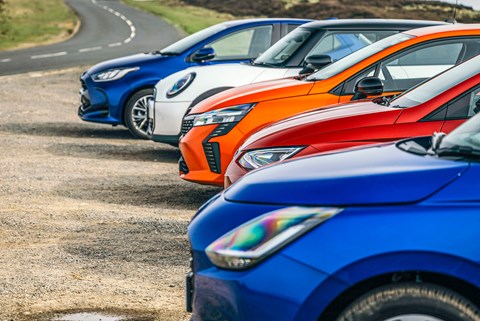
The new Clio is one of the cheapest here, starting at just under £18k, and sharp-eyed readers may notice this is CAR’s new long-term test car, which will surface online soon. It’s hard to miss it, finished in bright orange (a £700 option). This is the new facelifted version of the fifth-generation Clio, and in many ways it remains the archetypal supermini. It still looks pert and purposeful, and in base-model Evolution spec it’s neat and simple inside, with grey fabrics and a modest colour screen in the middle of the dash. It’s fitted with a perky 1.0-litre three-cylinder turbo engine, putting out just 89bhp, which drives the front wheels through a six-speed manual gearbox.
Nowadays at CAR we drive so many electric cars and automatics, so spending some time thrashing this Clio over the Yorkshire Moors is an absolute joy. The hands-on, analogue-feeling manual-ness of the Renault just makes me want to shout ‘Weh-hey!’ as I clip it through the twists and turns, bolting up and down the gears like I’m 17 years old again. The quick steering is accurate and the whole car seems happy to follow those front wheels wherever you point them. It has a brazen, sparkling chuckability about it, and even though the figures say it takes 12.2 seconds to reach 62mph (maxing out at 112mph) I promise, once it’s wound up to back-road speeds, its pace never seems as yawnsome as the numbers suggest.
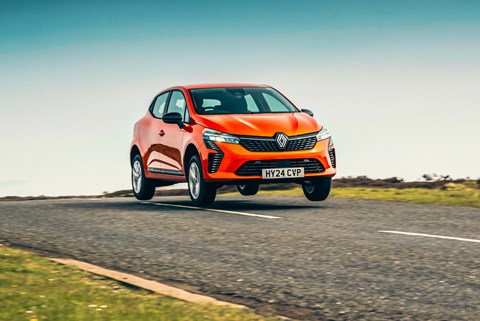
When I meet up with the rest of the team in the early-morning sunshine, the car that immediately catches my eye is the new Mini. Again, this is more of a substantial facelift than an entirely new model, though confusingly they’ve made it look identical to the completely new electric version. Called the Mini Cooper C (for ‘combustion’) it’s fractionally wider and shorter than the outgoing car. The new headlights look cool and modern, but at the rear the familiar lozenge-shaped lights are replaced by triangular clusters that don’t look very Mini-ish and make the tail look a bit pinched.
Our Cooper in Classic trim is powered by a 152bhp 1.5-litre three-cylinder, which starts at £22,300. However, this example has a £4k option pack, which adds a panoramic roof, Harman Kardon sound system and more. At over £27k, it’s not exactly cheap as chips, but don’t worry, I’m going to judge this Mini on the basics.
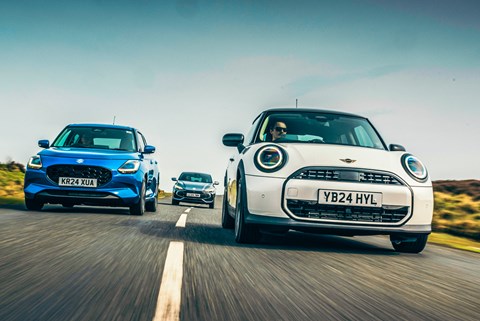
And the basics are good. As soon as you get in, it’s a world away from the Clio. The door closes with a solid thud. The interior is clearly designed to be tasteful, architectural and conspicuously DESIGNED. The dash is quite vertical and, with no big centre console, the interior feels very open and spacious. The huge new circular colour screen grabs your attention but there are lots of other lovely details, like the fabric edging to the non-leather leathery trim and the delicate air vents.
This grown-up, sophisticated mood continues when you drive. As soon as I pull away, I’m struck by the steering heft and the ridiculously thick steering wheel. It’s like holding two baked bean cans in your hands. The ride too – unlike the Clio, the Mini seems oddly big and heavy, and you feel as though the car is crushing the undulations below you, rather than dancing over them. True, it is heavier than the Renault by about 200kg, but that doesn’t entirely account for the way it feels. It’s been engineered this way – a conscious decision to make it feel solid and German.
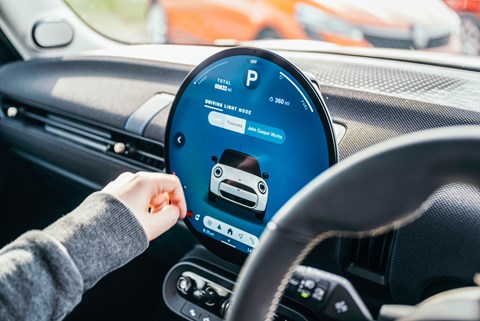
Thankfully it does also have a playful side. There are no paddles to manually change the seven-speed auto ’box, but when I start playing with the seven driving modes (or ‘Experiences’) I discover Go-Kart mode. This sharpens the throttle and stiffens the steering yet more. With a 0-62mph time of 7.7 seconds the Cooper is quick, and in Go-Kart mode it also adds enough zesty sharpness to compensate for the lack of gearshift paddles. That stiff steering does feel artificial, however, and while the Mini is certainly pointy and confident on these roads, it’s no go-kart. After a few miles I find myself slowing down and burbling back to the team.
Time to switch again.
It’s a real jolt, getting out of the Mini and straight into the Yaris. The Yaris 1.5 Hybrid is actually the second most expensive car here, at £26,710 in Excel trim (in Icon base spec it starts at £22,600). It combines a 114bhp 1.5-litre three cylinder with a small battery and an electric motor driving the front wheels through a preposterously complex e-CVT gearbox (there are YouTube videos explaining how it works – I don’t recommend them).
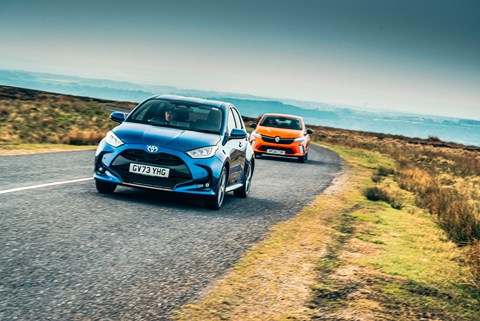
Despite all that mechanical sophistication, after the Mini the Yaris interior is an absolute dog’s dinner. The cheap-looking plastics bend and contort into convoluted shapes with no clear strategy, other than making sure the dashboard meets up with the centre console somehow. The seats are supportive – one of the Clio’s weaknesses – and after the Mini the steering wheel feels slender and wieldy like a tapered golf club. But on the move I immediately feel like I’m in the world of white-goods transportation. We like the Yaris platform – the wonderful GR hot hatch has so much natural balance (of course, it costs £45k); but at this end of the range, the direct feel of the Toyota’s steering is completely ruined by the drivetrain. The flat, never-ending drone of the engine driving that continuously variable gearbox delivers power with the monotonous linearity of a factory conveyor belt. It’s like driving a washing machine – without the thrill of the spin cycle at the end.
Next!
Time to get into the brand new MG 3 Hybrid+, the only four-cylinder engine here, and – with its electric motor – the most powerful too, offering nearly 200bhp. This should liven things up!
Like the Yaris, the new MG is hardly a looker, and compared to the minimalist Mini it’s a mish-mash of curves, swoops and body lines. Inside is better: there are two trim levels, SE and Trophy, and ours is the everything-thrown-in Trophy, which retails at £20,495. The dash is impressive and build quality of the switchgear is good. However, the seats let it down with cheap-feeling foam, like something Amazon would use for disposable packaging.
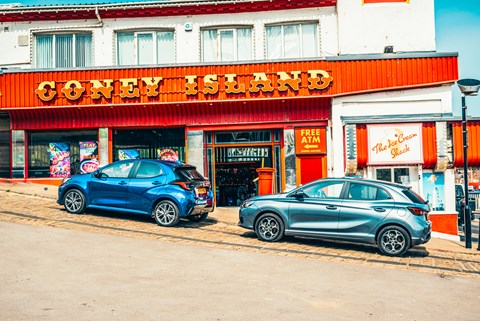
I’m excited to drive this car, though, because it’s a new twist to the supermini recipe. The four-pot engine isn’t turbocharged like the other cars, it’s a naturally aspirated 1.5-litre that runs on the Atkinson cycle. Quick, turn to Wikipedia! Atkinson engines run at a lower compression with an efficient fuel-burn. The compromise – a lower output at low revs – is then cancelled out by the 134bhp electric motor, which fills in the low-down torque. It’s clever and unusual and… oh God, it’s slow!
No, it’s fast. No, it’s slow and fast at the same time. What? The MG 3 is one of the weirdest cars I’ve ever driven.
It pulls away sharply enough but when you really put your foot down, there’s a strange lag as it seems to be working out what to do. MG boasts that the Hybrid+ drivetrain has five modes to choose from: EV, Series, Series and Charge, Drive and Charge, and Parallel. But it feels like the car is caught out, going, ‘Er, um, which mode now!?’
Then – sometimes – if you mash your foot to the floor at 50mph, the surge forward actually does feel convincingly quick. But it never feels like a 200bhp hot hatch and frustratingly the response you get seems unpredictable.
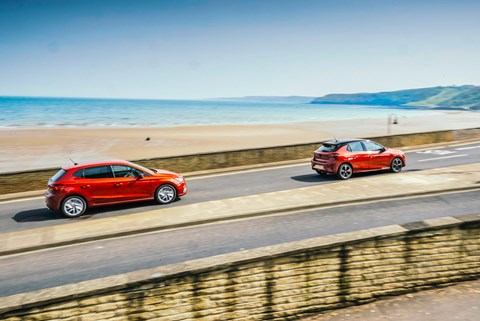
Looking for something a little more conventional, I turn to the Vauxhall Corsa. Originally dating back to 1983 (when it was badged the Nova) the Corsa comes from a grand old family of superminis, and the latest was brought fully up-to-date last year with a very successful facelift of the sixth-generation car. It’s good looking and its 99bhp, 1.2-litre turbocharged three-cylinder and six-speed manual box are refreshingly straightforward, compared to the Yaris and MG. Like the Clio, it’s a car that urges you on with its drummy three-pot engine noise, as you stoke up the revs with the manual box. Soon I have a smile on my face again.
In a couple of ways the Vauxhall is actually better than the Clio – it’s quicker, and the gearchange is smoother than the Renault’s notchy shift. However, I don’t like the interior, which feels a bit dated and dark with its glossy plastic inserts. The steering is less engaging than the Renault’s and the ride gets a bit fidgety on our moorland road. This new car makes for a more convincing supermini than many of the bland Corsas of the past, but it’s no winner in this company.
The next car could be a dark horse, though – the Suzuki Swift has been brilliant in the past. Could this new version surprise us all?
Well, the new styling certainly raises eyebrows. The strange, high bonnet line, lower headlights and pouty grille mean it resembles some kind of deep-sea guppy. Inside is more successful, and the two-tone trim and high-quality dimpled plastics feel premium, as does the decent-sized colour screen sticking out of the dash. What’s weird is the overall feel of high-ceilinged cabin space. It’s roomy but I feel perched upright, rather than lounging down in it.
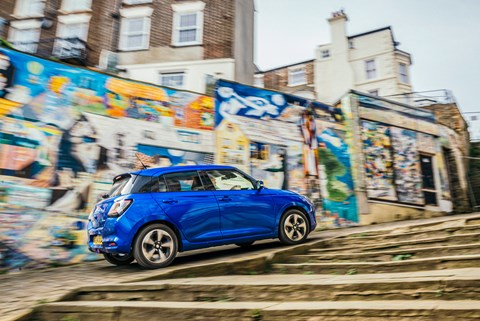
There are two trim levels, Motion and Ultra, and our car is the higher-spec Ultra starting at £19,800. There’s only one engine, a mild-hybrid 1.2-litre turbo three-cylinder, but three transmission options: a five-speed manual, CVT auto, or (unusually in this market) a manual with Allgrip four-wheel drive.
Ours is the regular front-drive manual and with just 81bhp on tap it’s the least powerful car in our group. It’s also the slowest, taking 12.5 seconds to reach 62mph, and – unlike the Clio, which hides its slow pace – the Swift really feels leisurely. Its problem is the torque, which is just 83lb ft peaking at 4500rpm. The Clio’s peak torque is 118lb ft at 2000rpm. So in the Swift you find yourself really revving and labouring the engine, and if you’re not in the right gear, thrashing it, the throttle response punishingly tame. Rather than making me feel like I’m 17 again, the Swift makes me feel like I’m in my gran’s car.
Better switch again, then, this time to the hottest hatch of our test. In some ways, the Hyundai i10 almost belongs to a different category to the other cars here, because it’s so small – it’s 20cm shorter than the Clio. However, in N-Line spec its stats are surprisingly similar to the rest of the pack: it has a 1.0-litre turbo triple, putting out 90bhp through a five speed manual, and the starting price is £18,630. And when you climb in the little Hyundai, you wouldn’t think it’s a smaller car, because the front half is supermini sized. It’s everything behind you that is truncated.
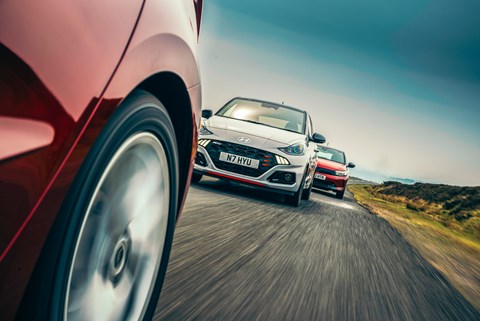
Because the N-Line is the sporty model, the i10 immediately feels stiffer than the other cars here. The steering is more resistant, especially at parking speeds, and the ride is firmer too. Initially it feels a bit much, but we’re searching for supermini fun here and once you’re up to speed the i10 feels taut and pointy, changing direction with tip-toe agility. I love the interior too, which feels modern and well thought out and the red highlights hark back to hot hatches of the 1980s. It’s a little longer geared than some of the others here, with only five speeds, but as long as you’re always willing to change down it has a revvy urgency to it.
So that’s it! I’ve driven them all, time to head down to Scarborough seafront for some fish and chips.
That’s when I realise – I’ve forgotten the Ibiza.
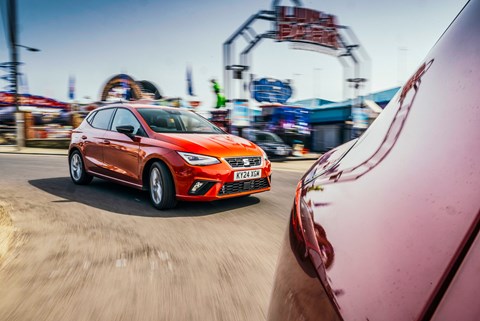
Marking its anniversary this year, the Ibiza has been a great little hatchback for 40 years now, but I have to say this latest version, the fifth generation, facelifted in 2021, looks like something from the 1990s. It is so vanilla and easy to overlook, I genuinely forgot to drive it. So I take it from the moors down to the coast, and once inside I’m pleasantly surprised. The interior has all the hallmarks of that classic VW Group quality, and the layout is clean and easy to live with. This FR model, which is well equipped but quite pricey at £23,600, comes with the now-familiar 1.0-litre tubocharged triple putting out 113bhp, driving the front wheels through a seven speed auto.
Unlike the annoying CVT gearboxes, however, the Seat has a Sport mode and paddles, and as I descend off the moors I have to say I have a great drive, manually changing, keeping the revs high and enjoying the precise steering. The FR trim level comes with slightly sportier suspension and while there isn’t a lot of feedback from the wheel, you can still punt the Ibiza along with confidence, trusting the ride and body control to soak up all the grief you’re giving it.
But when we land in Scarborough and I eat my battered cod off the bonnet of the Clio and try to reach some conclusions, I look at the Seat and decide it just cannot be in the top three today. No part of me desires the Ibiza, even though it’s very competent. It’s just too bland.
That factor of desirability takes out a couple of other cars too – nope, I do not want to own or drive the MG 3, clever though it is. Interestingly, for all that tech, it managed 51.7mpg on our test, which was no better than the conventional three-cylinder cars. So why bother? It’s certainly not a pleasure to drive.
Likewise the Yaris – clever, decent, boring. It actually scored our best economy at 55.7mpg, so there’s that, I suppose. But it’s far from a fun car to drive.
So if we’re looking for fun? The Corsa is quick but the interior lets it down. The Suzuki is slow, though it’s actually pretty good in lots of other ways, with that manual gearbox and being the lightest car here. I just couldn’t live with those looks.
Which brings us down to the last three. The Hyundai i10 N-Line is a great little car and probably the biggest surprise of the test. It really is an evocation of the hot hatches of the past, pocket-sized and raring to go. It’s let down by a ride that gets a bit crashy at times and by scratchy plastics on the dashboard.
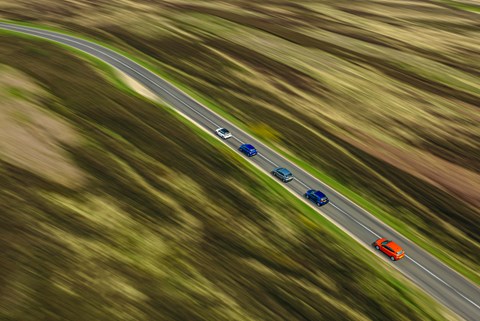
Whereas the interior materials and design are way up high among the Mini’s strengths. The Mini is in many respects the best car here, showing the way in its high design values. I could live with a Mini on my drive; I’d enjoy climbing into that cabin every day. And while I don’t love the fat steering wheel and fake steering weight, there’s no denying it has great pace on a back road.
What it doesn’t have is that lightweight, simple charm that a supermini should have – the manual gearbox, the sensitive steering, the feeling that it enjoys a good thrashing as much as you do. And that’s why for me the Clio is the winner.
The Renault may not have the Germanic, big-car sophistication of the Mini but it epitomises everything great about the supermini class – it’s so engaging, despite its lack of outright speed, and it marries everyday five-door practicality with a real sense of fun.
I’m glad cars like this are still being built – the next generation of car enthusiasts are going to love them.
Where are you, Fiesta?
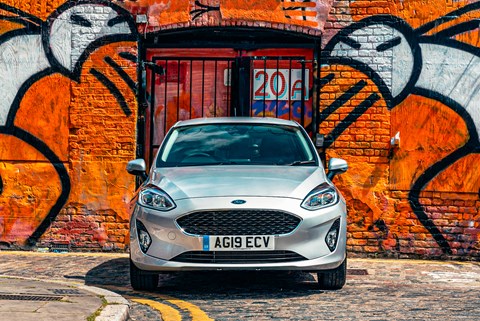
The death of the Fiesta a year ago leaves a big hole in the supermini market, especially for young and first-time drivers like me.
My relationship with the model began with my first-ever car, a fifth-generation manual Fiesta from 2007. A friend of mine bought one in a similar spec shortly after, except it had black badges on the rear instead of chrome – oh how we envied that.
Unlike some cheap-as-chips cars, there was nothing to be ashamed of in being seen in a clapped-out 12-year-old Fiesta. They felt complete – more stylish and with more road presence than a Clio or a C1, while generally in better condition, too, suggesting they were better made, or better cared for, or both. We all shared the assumption that these were simply the best first cars for your money.
Fast forward a few years and as we made our first steps into PCP, these assumptions were guiding our decision-making once again. Opting for a Fiesta felt like an instinctive choice. The seventh-generation car was the perfect all-rounder – well-built, well-equipped and still a model you’d be proud to own, no matter your age. Right into its twilight years, the Fiesta was the model for discerning first-time drivers.
The competition it leaves behind is strong, but no match for that legacy.
By Seth Walton
Supermini super-test: the specs
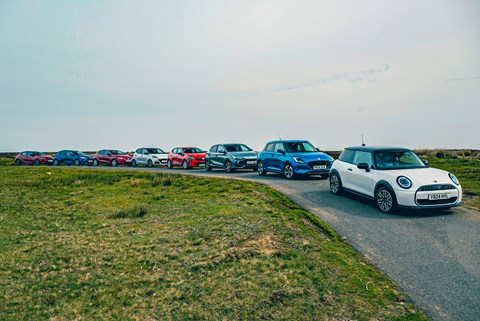
Renault Clio TCe 90 Evolution
Price £17,995 (£18,695 as tested)
PCP £191 a month
Powertrain 999cc 12v turbocharged three-cylinder, six-speed manual, front-wheel drive
Performance 89bhp @ 5000rpm, 118lb ft @ 2000rpm, 12.2sec 0-62mph, 112mph
Weight 1174kg
Efficiency 54.3mpg (official), 43.8mpg (tested), 118g/km CO2
Suzuki Swift Ultra
Price £19,799 (£20,499 as tested)
PCP £199 a month
Powertrain 1197cc 12v turbocharged three-cylinder, five-speed manual, front-wheel drive
Performance 81bhp @ 5700rpm, 83lb ft @ 4500rpm, 12.5sec 0-62mph, 103mph
Weight 984kg
Efficiency 64.2mpg (official), 54.6mpg (tested), 99g/km CO2
Vauxhall Corsa GS 1.2
Price £22,905 (£23,605 as tested)
PCP £194 a month
Powertrain 1199cc 12v turbocharged three-cylinder, six-speed manual, front-wheel drive
Performance 99bhp @ 5500rpm, 184lb ft @ 1750rpm, 9.9sec 0-60mph, 120mph
Weight 1100kg
Efficiency 54.3-55.4mpg (official), 38.5mpg (tested), 114-117g/km CO2
Toyota Yaris Hybrid Excel
Price £26,710 (£26,710 as tested)
PCP £341 a month
Powertrain 1490cc 12v turbocharged three- cylinder, 0.8kWh battery, e-motor, e-CVT automatic, front-wheel drive
Performance 114bhp @ 5500pm, 89lb ft @ 3600rpm, 9.7sec 0-62mph, 109mph
Weight 1190kg
Efficiency 65.6mpg (official), 55.7mpg (tested), 97g/km CO2
MG3 Hybrid+ Trophy
Price £20,495 (£20,495 as tested)
PCP £255 a month
Powertrain 1499cc 16v four-cylinder, 1.83kWh battery, e-motor, three-speed automatic, front-wheel drive
Performance 192bhp @ 6000rpm, 184lb ft @ 4500rpm, 8.0sec 0-62mph, 106mph
Weight 1308kg
Efficiency 64.2mpg (official), 51.7mpg (tested), 100g/km CO2
Hyundai i10 N-Line
Price £18,630 (£19,430 as tested)
PCP £215 a month
Powertrain 998cc 12v turbocharged three-cylinder, five-speed manual, front-wheel drive
Performance 90bhp @ 4500rpm, 127lb ft at 1500rpm, 11.4sec 0-62mph, 109mph
Weight 1024kg
Efficiency 52.3mpg (official), 42.9mpg (tested), 123g/km CO2
Seat Ibiza FR
Price £23,600 (£23,600 as tested)
PCP £280 a month
Powertrain 999cc 12v turbocharged three-cylinder, seven-speed automatic, front-wheel drive
Performance 113bhp @ 5500rpm, 148lb ft @ 2000rpm, 9.9sec 0-62mph, 123mph
Weight 1178kg
Efficiency 48.7-51.4mpg (official), 43.9mpg (tested), 126g/km CO2
Mini Cooper C Classic
Price £22,300 (£27,400 as tested)
PCP £243 a month
Powertrain 1499cc 12v turbocharged three-cylinder, seven-speed automatic, front-wheel drive
Performance 152bhp @ 4900rpm, 170lb ft @ 1500rpm, 7.7sec 0-62mph, 139mph
Weight 1335kg
Efficiency 47.1mpg (official), 40.3mpg (tested), 135g/km CO2